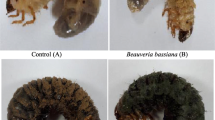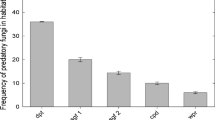Abstract
A total of 28 species representing 15 fungal genera were found to be associated with the all different stages of the Egyptian cotton leafworm,Spodoptera littoralis Boisd., its faeces and the air of the containers where it was reared on Czapek Dox agar medium at 28°C.Aspergillus was the most common genus and was frequently isolated from all substrates.A. flavus was the only fungus associated with all insect stages. At least two well known facultative pathogens were obtained:Beauveria alba andCephaliophora tropica. Nearly all fungi recovered from insect faeces or its environment were also encountered from different insect stages. Forty-two isolates were tested for their abilities for growth on a synthetic medium (nitrogen- and carbon-free) containing partially purified chitin. Most (76.2%) had moderate growth rates.
Similar content being viewed by others
References
Abdou RF, Megalla SE, Azab SG. Mutagenic effects of aflatoxin B-1 and G-1 on the Egyptian cotton leafworm,Spodoptera littoralis (Boisd.). Mycopathologia 1984; 88: 23–6.
Chinnici J, Liewellyn GC. Reduced aflatoxin toxicity in hybrid crosses of aflatoxin B-1 sensitive and resistant strains ofD. melanogaster. J Inverteb Pathol 1979; 33: 81–5.
Frjederichs K, Bally W. Over de parasitische Schimmels, die den Koffiebessenboekboek-Fonds 1925; No. 6: 103–7 (+7 plates) Malang.
McMillian WW, Wilson DM, Widstrom NW, Perkins WD. Effect of aflatoxin B-1 and G-1 on 3 insect pest of maize (Zea mays L.). J Econ Entomol 1980; 73: 26–8.
Moore D, Prior C. Present status of biological control of the coffee berry borerHypothenemus hampei. Brighton Crop Protection Conference-Pests and Diseases 1988; 1119–24.
Murakoshi S. Productivity of aflatoxins and some biological effects inAspergillus flavus isolated from cadaver of the silkworm,Bombyx mori L. App Ent Zool 1977; 12: 255–59.
Pascalet P. La lutte biologique contreStephanoderes hampei ou scolyte du cafeier au Cameroun. Rev Bot App Agric Trop 1939; 19: 753–64.
El-Sayed GN, El-Guindy MA. Resistance spectrum and sub-grouping of organophosphorous compounds in a field population of the cotton leafworm,Spodoptera littoralis (Boisd.) (Lepidoptera: Noctuidae). Bull Ent Soc Egypt, Econ Ser 1975; 9: 147–55.
Imms AD. A general textbook of entomology, 9th ed. London: Methuen, 1957; 512–33.
Kamil AA, Hanna A, Soliman S, Shoeb A. Studies on the effect of some new insecticides on the cotton leafworm and bollworm. Agric Res Rev, Ministry Agriculture, Egypt 1958; 36: 1–23.
Al-Doory Y. Laboratory medical mycology. Philadelphia: Lea and Febiger, London: Kimpton Publishers, 1980: 1–410.
Smith NR, Dawson VT. The bacteriostatic action of rose bengal in media used the plate count of soil fungi. Soil Science 1944; 58: 467–71.
Booth C. The genusFusarium. Kew, Surrey (UK): Commonwealth Mycological Institute, 1971: 1–237.
Booth C.Fusarium, Laboratory guide to identification of the major species. Kew, Surrey (UK): Commonwealth Mycological Institute, 1977: 1–58.
Christensen M, Raper KB. Synoptic Key toAspergillus nidulans group species and relatedEmericella species. Trans Br Mycol Soc 1978; 71: 177–91.
De Hoog GS. The generaBeauveria, Isaria, Tritirachium andAcrodontium Gen. Nov. [Studies in Mycology, No. 1]. Baarn: Centraalbureau voor Schimmelcultures, 1972; 1–41.
Domsch KH, Gams W, Anderson TH. Compendium of soil fungi. London: Academic Press, 1980: 1–859.
Kozakiewicz Z.Aspergillus species on stored products [Mycological papers, No. 161]. Kew, Surray (UK): Commonwealth Mycological Institute, 1989; 1–188.
Morton FJ, Smith G. The generaScopulariopsis Bainier,Microascus Zukal andDoratomyces Corda [Mycological papers, No. 8]. Kew, Surrey (UK): Commonwealth Mycological Institute, 1963: 1–96.
Pitt JI. The genusPenicillium and its teleomorphic statesEupenicillium andTalaromyces. London: Academic Press, 1979: 1–634.
Raper KB, Fennell DI. The genusAspergillus. Huntington, NY: Krieger Publ Comp, 1977: 1–686.
Samson RA. A compilation of theAspergilli described since 1965 [Studies in Mycology]. Baarn: Centraalbureau voor Schimmelcultures, 1979; 18: 1–40.
Zycha H. Mucorineae von Kryptogamenflora der Mark Brandenburg. Band Vi(a): Pilze II. Weinheim (Germany): Verlag J. Cramer. New York: Johnson Reprint Corporation, 1963: 1–264.
Guthrie WD, Lillehoj EB, Barry D, McMillian WW, Kwolek WF, Franz AO, Catalano FA, Russell WA, Widstrom NW. Aflatoxin contamination of preharvest corn: Interaction of European corn borer larvae andAspergillus flavus-group isolates. J Econom Entomol 1982; 75: 265–9.
Fennell DI, Lillehoj EB, Kwolek WF, Guthrie WD, Sheeley R, Sparks AN, Widstrom NW Adams GL. Insect larval activity on developing corn ears and subsequent aflatoxin contamination of seed. J Econ Entomol 1978; 71: 624–28.
Lillehoj EB, McMillian WW, Widstrom NW, Guthrie WD, Jarvis JL, Barry D, Kwolek WF. Aflatoxin contamination of maize kernels before harvest: Interaction ofAspergillus flavus spores, corn earworm larvae and fungicide applications. Mycopathologia 1984; 86: 77–81.
Lillehoj EB, McMillian WW, Guthrie WD, Barry D. Aflatoxin-producing fungi in preharvest corn: Inoculum source in insects and soils. J Environ Qual 1980; 9: 691–4.
Beal RH, Kais AG. Apparent infection of subterranean termites withAspergillus flavus Link. J Insect Pathol 1962; 4: 488–9.
Gambino P, Thomas GM. Fungi associated with twoVespula (Hymenoptera: Vespidae) species in the eastern San Francisco Bay area. Pan-Pacific Entomologist 1988; 64: 107–13.
Catalogue of the Culture Collection, 9th ed. Kew, Surrey (UK): Commonwealth Mycological Institute, 1988.
Sussman AS. Studies of an insect mycosis I: Etiology of the disease. Mycologia 1951; 43: 338–50.
Zoberi MH, Grace JK. Fungi associated with the subterranean termiteReticulitermes flavipes in Ontario. Mycologia 1990; 82: 289–94.
Patay R. Sur un champignon parasite du Doryphorae. (Leptinotarsa decemlineata Say). Bull Soc Sci Bretagne 1935; 12: 62–6.
Novak J. Zprava o cinnosti sekce fytopathologicke. Veröffentl Pytopath Sect d Morav Agr Expt Inst in Brunn 1–16. 1924. Abstr Rev Appl Mycol 1925; 4: 529.
Hornbostel W. KannBeauveria densa Link. auch die eier des Maikäfers befallen? Z Pflanzenkrankh Pflanzenschutz 1939; 49: 142–4.
Reyes GM. Artificial infection of the coconut leaf miner withBeauveria globulifera (Speg.) Picard. Pillippine J Sci 1932; 49: 419–41.
MacLeod DM. Investigations on the generaBeauveria Vuill. andTritirachium Limber. Can J Botany 1954; 32: 818–91.
Steinhaus EA. Principles of insect pathology. New York: McGraw Hill, 1949.
Sherief AA, El-Sawah MMA, Abd El-Naby MA. Some properties of chitinase produced by a potentAspergillus carneus strain. Appl Microbiol Biotech 1991 (in press).
Bridge PD, Abraham YJ, Cornish MC, Prior C & Moore D. The chemotaxonomy ofBeauveria bassiana (Deuteromycotina: Hyphomycetes) isolates from the coffee berry borerHypothenemus hampei (Coleoptera: Scolytidae). Mycopathologia 1990; 111: 85–90.
Gupta SC, Leathers TD, El-Sayed GN, Ignoffo CM. Production of degradative enzymes byMetarrhizium anisopliae during growth on defined media and insect cuticle. Experimental Mycology 1991; 15: 310–15.
Samuels KDZ, Heale JB, Llewellyn M. Charactheristics relating to the pathogenicity ofMetarhizium anisopliae towardsNilaparvata lugens. J Invert Pathol 1989; 3: 25–31.
St Leger RJ, Durrands PK, Charnley AK, Cooper RM. Role of extracellular chymoelastase in the virulence ofMetarhizium anisopliae forManduca sexta. J Invert Pathol 1988; 52: 285–93.
Author information
Authors and Affiliations
Rights and permissions
About this article
Cite this article
Ismail, M.A., Abdel-Sater, M.A. Fungi associated with the Egyptian cotton leafwormSpodoptera littoralis Boisdoval. Mycopathologia 124, 79–86 (1993). https://doi.org/10.1007/BF01103106
Received:
Accepted:
Issue Date:
DOI: https://doi.org/10.1007/BF01103106




